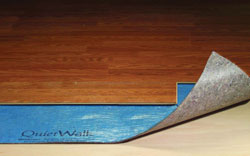In the underlayment universe, marketing departments sometimes deal in excess. If performance specifications seem too good to believe and/or  warranties are limited, look more closely at the products to make sure they really do cut the mustard.
warranties are limited, look more closely at the products to make sure they really do cut the mustard.
In evaluating underlayment, acoustical consultants commonly rely on tests to define how well a floor/ceiling assembly insulates against noise created by impact and airborne vibration.
IIC is a popular impact sound insulation test for floor-to-ceiling assemblies. An IIC rating generally ranges between a low of 20 to a high of 80. The International Building Code’s minimum standards for multi- family dwellings is 50 for new construction, or 45 if field tested in an actual building after the floor installation is complete. Most high rise and condominium associations also require a minimum of 50.
Some products advertise substantially higher IIC ratings than 50, much closer to the top of the scale. But what was the complete floor assembly for that test? Did the tested assembly include plush carpeting? And what was the structural floor? Was there an acoustical, suspended ceiling? Again, an IIC test includes the entire floor-to-ceiling assembly—from the surface of the flooring material down to the ceiling in the unit below. Test results for underlayments reported without revealing the description of the whole floor assembly is basically meaningless. Be sure to ask for the complete test report with a description of the entire test sample.
Before stocking products, it also pays to review warranties with a keen eye. Be careful that the warranty does not set up unexpected pre-conditions that, if not complied with, could render the warranty void.
For instance, if the product is to be installed over a concrete subfloor, a warranty might require a calcium chloride test. This would be to determine how much moisture the concrete releases in 24 hours prior to installation of the product. It is also to make sure the subfloor is not giving off more moisture than the floor manufacturer recommends.
Wood flooring manufacturers, for example, do not recommend putting their products directly over a concrete floor with a reading over 3.5 to 4 pounds per thousand square feet for 24 hours conducted over a 72 hour period.
Industry guidelines
Typical limits for direct gluedown wood flooring are 3 pounds, according to the National Wood Flooring Association’s (NWFA) Moisture Guidelines and Moisture Testing, Calcium Chloride Test ASTM F-1869, Appendix C. When readings are over 3 pounds and up to 7 pounds, NWFA notes, “you must use a vapor retarder.” It goes on to state that a reading over 7 pounds may not be acceptable for wood flooring installation.
Because of the industry’s recognition that many types of finished floors should not be put over concrete subfloors giving off more than 3.5 to 4 pounds of moisture per thousand square feet in 24 hours, there is very little value in an extravagant warranty for an underlayment mill that touts a moisture guarantee much higher than that. It would essentially be a worthless sales claim since flooring manufacturers
do not recommend installing the underlayment in high moisture areas, anyhow.
Furthermore, does a warranty clarify where the moisture comes from—above or below— and does it explain what method would be used to mitigate it? Some moisture barriers contain and retain moisture, which is not preferred. Others may, indeed, dissipate moisture, which is preferred.
When evaluating an underlayment warranty, take note of exactly what and who is covered. Don’t assume. If you are interested in protecting your relationship with your customers—whether retailers or consumers—evaluate what exactly the manufacturer’s warranty offers everyone along the line. As the often-true saying goes, “the large print giveth and the small print taketh away.”
Gotcha
All warranties carry exclusions, terms and conditions, any of which can serve as “gotchas” that render the warranty less potent than you or your consumer wants. A great deal of technical language that sounds impressive may actually disqualify the consumer from any claims after installation.
Warranties explicitly stating they apply to the first purchaser (the distributor) may not ever apply to the consumer. When the distributor sells the product to a consumer, there are no con- tract privities between the manufacturer and the consumer and the right to enforce the promise to the end user is lacking.
Furthermore, if the warranty limits the dollar amount per square foot as well as the total dollar amount of any claim— regardless of the number of square feet of underlayment installed—the distributor, to protect itself, should not sell more than the warranty limit. If the warranty limits the manufacturer’s exposure, who pays the difference? It is also important to determine the types of flooring to which an underlayment warranty applies. If your customer is putting in an engineered wood floor or a laminate floor over the underlayment and the warranty explicitly states it is for hardwood flooring then the material would not be covered right off the bat, thus rendering the warranty useless, as well. And, watch out for disqualifying words such as “notwithstanding” in front of qualifying phrases, especially when used to mean “even though there is a warranty, we don’t recommend use of the product in such and such conditions.” That kind of qualification seems to be passing the buck, shifting the burden from the manufacturer to the purchaser once again.
The best performance claims clearly state the truth while the best warranties provide protection to all parties.
-Lloyd Rogers
